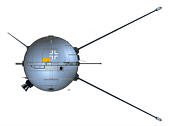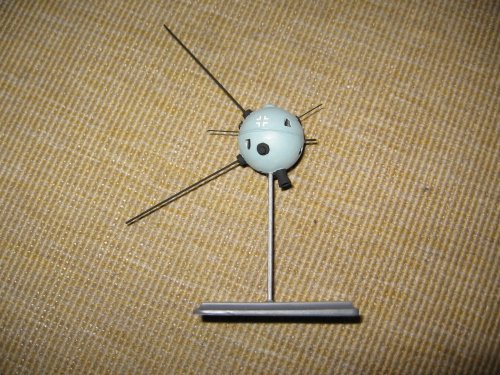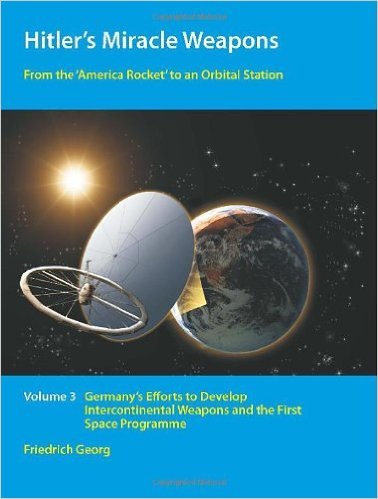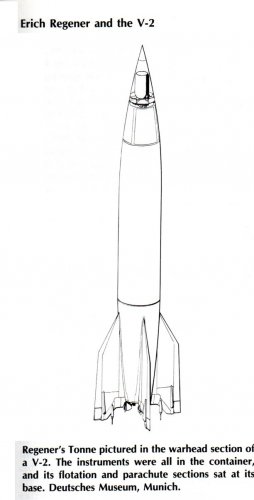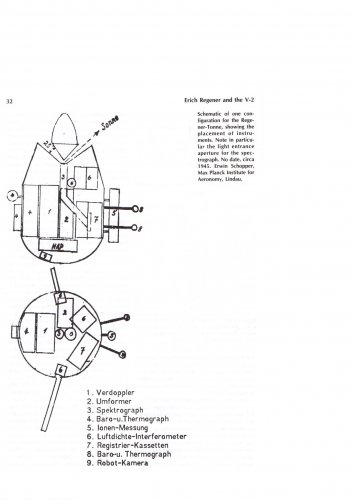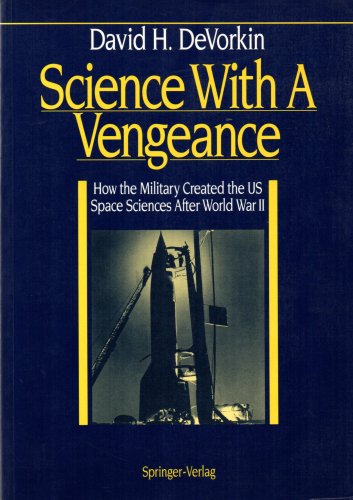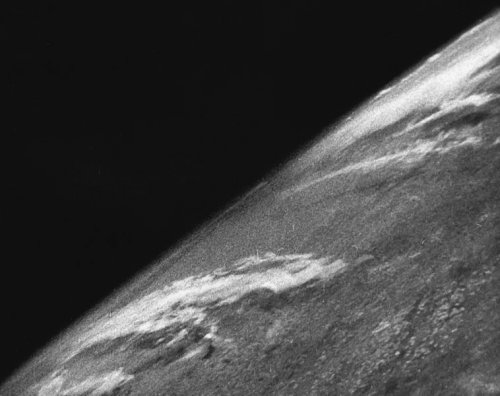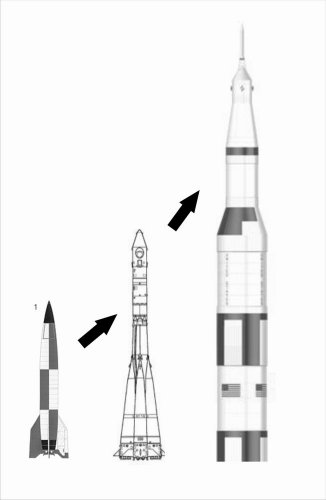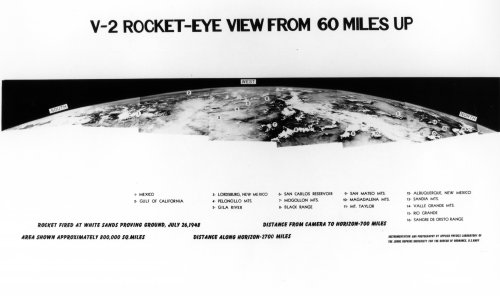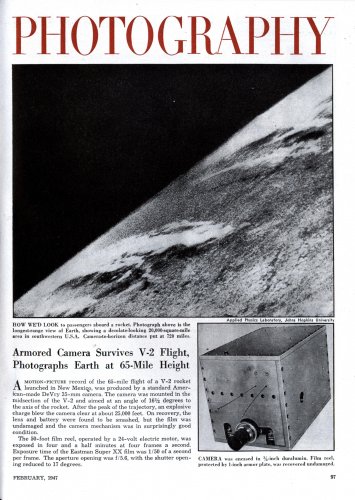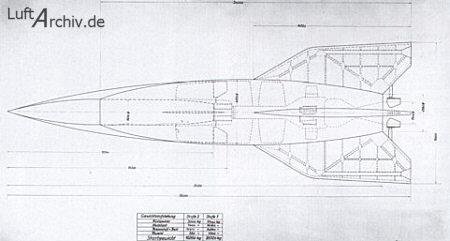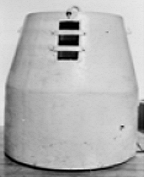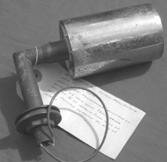You are using an out of date browser. It may not display this or other websites correctly.
You should upgrade or use an alternative browser.
You should upgrade or use an alternative browser.
German WWII Space Satellite ?!
- Thread starter Vladimir
- Start date
XP67_Moonbat
ACCESS: Top Secret
- Joined
- 16 January 2008
- Messages
- 2,272
- Reaction score
- 545
Ridiculous!
I call BULLSHIT!
I call BULLSHIT!
That image is from the Unicraft Models website?
Vladimir
I really should change my personal text
- Joined
- 22 September 2015
- Messages
- 321
- Reaction score
- 53
Hobbes said:That image is from the Unicraft Models website?
Yes, Hobbes
- Joined
- 11 March 2006
- Messages
- 8,626
- Reaction score
- 3,811
XP67_Moonbat said:I call BULLSHIT!
That was my first reaction, too.
But perhaps let us have a closer look:
- That satellite has very much in common with the Soviet Sputnik. Too much, I think, thoughts like
"look, they just copied, what they captured from the Germans" probably are around the corner
and I wouldn't be surprised, if that was the intention !
- Don't know of any mention, that rockets were regarded as something else, as a way to transport
bombs (the development just started as a substitute for long range artillery) or may be men. Have
found no indication, that space flight was really envisaged and if so, probably rather in a way similar
to that, shown by the UFA motion picture company ("Frau im Mond"). Though mentioned by some
rocket scientists after the war, as the true reason for their efforts, I think of this rather as an excuse.
- And the problems, the German "rocket industry" was still facing up to 1945, were far too big, to my
opinion, to allow for any digressions from the principally target: To deliver a payload, as heavy as possible,
as far as possible to targets on earth, not in space !
- Last, UNICRAFT is known for producing models of "rare types", but especially about German WW II aircraft and
weapons, I think, they shouldn't be regarded as a reliable source. They probably have done their share to
make projects like the V4 or V7 Feuerball "real" . :
That's why I moved this topic to this section, at least until we get confirmation from a more reliable source.
lastdingo
Blogger http://defense-and-freedom.blogspot.de/
Actually, the rocket developers dreamt of rocket-powered aircraft or flight to moon, not of lobbing explosives into London.
The utility of a satellite was not fully recognized, though - the one exception I know of was a (post-war?) fantasy of a huge ring-shaped space station as a base for moon or mars travels.
The utility of a satellite was not fully recognized, though - the one exception I know of was a (post-war?) fantasy of a huge ring-shaped space station as a base for moon or mars travels.
archipeppe
ACCESS: Top Secret
- Joined
- 18 October 2007
- Messages
- 2,435
- Reaction score
- 3,165
The Unicraft design is obviously derived from the original Sputnik.
von Braun always dreamed to use his rockets for scientific purposes but never dare the SS due to the Hitler's strict orders to use rockets exclusively as wespons.
Korolev were forced to design from scratch the "Object PS" also known as Sputnik since the original planned Russian first satellite the "Object D" (later launched as Sputnik 3) was behind the schedule. He assigned the task to his OKB-1 lead designer Mikhail S. Khomyakov who accomplished the task in a real crash programme aimed to realize a real simple satellite able to stand the space environment and transmit radio signal to ground.
The result was the Простейший Спутник-1 "Elementary Satellite 1", designed as a mere sphere (since the simplest shape) in two units a main one and a backup one.
At times when PS-1 was designed and built all the German scientists previously located in USSR (the Gottrupp group) were already returned to homeland so not was possible any German influence on its design (as it could be the case for the R-7 rocket).
The backup unit still exists today.
von Braun always dreamed to use his rockets for scientific purposes but never dare the SS due to the Hitler's strict orders to use rockets exclusively as wespons.
Korolev were forced to design from scratch the "Object PS" also known as Sputnik since the original planned Russian first satellite the "Object D" (later launched as Sputnik 3) was behind the schedule. He assigned the task to his OKB-1 lead designer Mikhail S. Khomyakov who accomplished the task in a real crash programme aimed to realize a real simple satellite able to stand the space environment and transmit radio signal to ground.
The result was the Простейший Спутник-1 "Elementary Satellite 1", designed as a mere sphere (since the simplest shape) in two units a main one and a backup one.
At times when PS-1 was designed and built all the German scientists previously located in USSR (the Gottrupp group) were already returned to homeland so not was possible any German influence on its design (as it could be the case for the R-7 rocket).
The backup unit still exists today.
Avimimus
ACCESS: Top Secret
- Joined
- 15 December 2007
- Messages
- 2,429
- Reaction score
- 911
archipeppe said:The Unicraft design is obviously derived from the original Sputnik.
von Braun always dreamed to use his rockets for scientific purposes but never dare the SS due to the Hitler's strict orders to use rockets exclusively as wespons.
A convenient tale after his rehabilitation, isn't it?
I'm not suggesting he wasn't interested in science. However, if you read the second half of Goethe's Faustus you'll see the scientist bring Prussia's enemies to their knees being presented as a good. It wasn't uncommon for people to feel that fighting for their country is an inherent good. Of course, that meant supporting the Nazi's, using forced labour and targeting civilians in this case...
Vladimir
I really should change my personal text
- Joined
- 22 September 2015
- Messages
- 321
- Reaction score
- 53
Hi, Guys! Here is what i found on e-bay:
Short info text: Already, during the early 1940's, Wernher von Braun had the vision, to have satellites orbiting earth (which would have had pure military purposes during that times). First trials with such a project, which was called an "Artificial Moon" were to be done from 1944 onwards.
First studies showed a spherical satellite, weighing in at 200 kg, which was to be sent into a low earth orbit by a three-stage rocket consisting of a EMW A-10/A-4/A-5 combination.
The second project, worked out by the "Kammler Group" (headed by SS-General Hans Kammler) in Peenemünde (Germany's rocket development center at the Baltic Sea), the "Satelloid", was also a spheric design and was to be equipped with cameras and radio antennas. Flight ceiling was to be 500 km and the "Satelloid" was to have an internal power unit also, which would have been used for course corrections.
In Kochel (an Upper-Bavarian City in the Alps), a reduced scale mockup was built for wind tunnel tests.
The oncoming end of WW II and various unsolvable problems with transportation meant that all work ceased then. Post war develpoment based on captured German data led to the development of "Vanguard" and "Sputnik".
So this project seem to be plausible...
Short info text: Already, during the early 1940's, Wernher von Braun had the vision, to have satellites orbiting earth (which would have had pure military purposes during that times). First trials with such a project, which was called an "Artificial Moon" were to be done from 1944 onwards.
First studies showed a spherical satellite, weighing in at 200 kg, which was to be sent into a low earth orbit by a three-stage rocket consisting of a EMW A-10/A-4/A-5 combination.
The second project, worked out by the "Kammler Group" (headed by SS-General Hans Kammler) in Peenemünde (Germany's rocket development center at the Baltic Sea), the "Satelloid", was also a spheric design and was to be equipped with cameras and radio antennas. Flight ceiling was to be 500 km and the "Satelloid" was to have an internal power unit also, which would have been used for course corrections.
In Kochel (an Upper-Bavarian City in the Alps), a reduced scale mockup was built for wind tunnel tests.
The oncoming end of WW II and various unsolvable problems with transportation meant that all work ceased then. Post war develpoment based on captured German data led to the development of "Vanguard" and "Sputnik".
So this project seem to be plausible...
Attachments
archipeppe
ACCESS: Top Secret
- Joined
- 18 October 2007
- Messages
- 2,435
- Reaction score
- 3,165
All this story is a fake with the only purpose to provide a plausible history as background to such what if model.....Vladimir said:Hi, Guys! Here is what i found on e-bay:
Short info text: Already, during the early 1940's, Wernher von Braun had the vision, to have satellites orbiting earth (which would have had pure military purposes during that times). First trials with such a project, which was called an "Artificial Moon" were to be done from 1944 onwards.
First studies showed a spherical satellite, weighing in at 200 kg, which was to be sent into a low earth orbit by a three-stage rocket consisting of a EMW A-10/A-4/A-5 combination.
The second project, worked out by the "Kammler Group" (headed by SS-General Hans Kammler) in Peenemünde (Germany's rocket development center at the Baltic Sea), the "Satelloid", was also a spheric design and was to be equipped with cameras and radio antennas. Flight ceiling was to be 500 km and the "Satelloid" was to have an internal power unit also, which would have been used for course corrections.
In Kochel (an Upper-Bavarian City in the Alps), a reduced scale mockup was built for wind tunnel tests.
The oncoming end of WW II and various unsolvable problems with transportation meant that all work ceased then. Post war develpoment based on captured German data led to the development of "Vanguard" and "Sputnik".
So this project seem to be plausible...
XP67_Moonbat
ACCESS: Top Secret
- Joined
- 16 January 2008
- Messages
- 2,272
- Reaction score
- 545
I could sell you a preserved piece of dog crap on EBay and state it's moon rock from Apollo 11. Doesn't mean it actually is.
Vladimir said:In Kochel (an Upper-Bavarian City in the Alps), a reduced scale mockup was built for wind tunnel tests.
Why, in the bowels of Cthulhu, would you build a wind tunnel model of a *satellite?*

archipeppe
ACCESS: Top Secret
- Joined
- 18 October 2007
- Messages
- 2,435
- Reaction score
- 3,165
Vladimir said:I thiks the answer is in this book...I'm not shure..Did any one read it?
Science fiction book that exploits some real feature of German aerospace history extending them into a real world that never happened.
von Braun surely dreamed up about a wheel space station and probably talked with General Dornberger as possible weapon platform but nothing far than a sketch (if even) for sure never became a real project or something that Hitler really wanted at that times.
The real first von Braun satellite design came up in the mid 50's with the famous Collier's article when it was introduced the concept of "Baby satellite" essentially made by the nosecone of proposed rocket.
- Joined
- 11 March 2006
- Messages
- 8,626
- Reaction score
- 3,811
Vladimir said:..Did any one read it?
I would strongly recommend a research about that author. You may use the search function here,
which already will give you some results and a clue about his credibility. Or just use Google. And yes,
there are people believing in those things like (actually tested !) German nuclear bombs or German
flying saucers, but probably not that many here.
Vladimir
I really should change my personal text
- Joined
- 22 September 2015
- Messages
- 321
- Reaction score
- 53
Justo Miranda said:The origin of the myth
Thanks,Justo. Looks impressive, what is it ?
- Joined
- 11 March 2006
- Messages
- 8,626
- Reaction score
- 3,811
Erich Regener was researching about ionisating cosmic radiation already during the '30s.
High-altitude balloons could reach an altitude of up to 30 km. Atmospheric data from those
altitudes and, if possible higher, were of interest for the team around Wernher von Braun,
too, so the project was born for a capsule (the so-called "Regener-Tonne" Regener Barrel),
carrying instrumentation for gathering flight data of the A4/V2 up to a height of about 50 km,
from where it would return via parachute. A kind of sounding rocket, far away from a satellite,
but I agree with Justo, that it may well the origin of the story about a "German space satellite".
For further reading wiki isn't that bad here : https://de.wikipedia.org/wiki/Erich_Regener ,
https://de.wikipedia.org/wiki/Regener-Tonne
High-altitude balloons could reach an altitude of up to 30 km. Atmospheric data from those
altitudes and, if possible higher, were of interest for the team around Wernher von Braun,
too, so the project was born for a capsule (the so-called "Regener-Tonne" Regener Barrel),
carrying instrumentation for gathering flight data of the A4/V2 up to a height of about 50 km,
from where it would return via parachute. A kind of sounding rocket, far away from a satellite,
but I agree with Justo, that it may well the origin of the story about a "German space satellite".
For further reading wiki isn't that bad here : https://de.wikipedia.org/wiki/Erich_Regener ,
https://de.wikipedia.org/wiki/Regener-Tonne
archipeppe
ACCESS: Top Secret
- Joined
- 18 October 2007
- Messages
- 2,435
- Reaction score
- 3,165
Vladimir said:Hi, is it sattelite?
This is a clear fake.
The rocket depicted is (obviously) the A4 while the capsule depicted is part of an English post-war proposal called "Megaroc" (aimed to achieve manned suborbital flight), issued by BIS (British Interplanetary Society) chairman R. A. Smith.
All the details in the following link:
http://www.bis-space.com/what-we-do/projects/megaroc
- Joined
- 13 August 2007
- Messages
- 8,465
- Reaction score
- 11,073
Let face it
There is NO WAY that Nazi could have launch Satellite in 1945
The A4 (aka V2) had not enough power to bring something in low earth orbit
of course Von Braun worked on A9/A10 a two stage rocket, but that was Paperwork and it's production site were under construction as War ended.
Another problem is that SS run the program, they consider this as Weapon NOT as scientific tool !
They even arrested Von Braun as he once talk about Space exploration in german pub.
The charge "Wehrkraftzersetzung" aka "subversion of the war effort", "undermining military morale" and "sedition and defeatism"
something what the SS execute by shooting...
lucky for Von Braun, he was to important for A4 project.
There is NO WAY that Nazi could have launch Satellite in 1945
The A4 (aka V2) had not enough power to bring something in low earth orbit
of course Von Braun worked on A9/A10 a two stage rocket, but that was Paperwork and it's production site were under construction as War ended.
Another problem is that SS run the program, they consider this as Weapon NOT as scientific tool !
They even arrested Von Braun as he once talk about Space exploration in german pub.
The charge "Wehrkraftzersetzung" aka "subversion of the war effort", "undermining military morale" and "sedition and defeatism"
something what the SS execute by shooting...
lucky for Von Braun, he was to important for A4 project.
archipeppe
ACCESS: Top Secret
- Joined
- 18 October 2007
- Messages
- 2,435
- Reaction score
- 3,165
Michel Van said:Let face it
There is NO WAY that Nazi could have launch Satellite in 1945
The A4 (aka V2) had not enough power to bring something in low earth orbit
of course Von Braun worked on A9/A10 a two stage rocket, but that was Paperwork and it's production site were under construction as War ended.
Another problem is that SS run the program, they consider this as Weapon NOT as scientific tool !
They even arrested Von Braun as he once talk about Space exploration in german pub.
The charge "Wehrkraftzersetzung" aka "subversion of the war effort", "undermining military morale" and "sedition and defeatism"
something what the SS execute by shooting...
lucky for Von Braun, he was to important for A4 project.
I quote Michel word for word.
Even if Germans were the best rocket scientists of their era it was absolutely not possible to launch a satellite up to 1945 due to the above reasons.
But what if they fired the A4 from their moon base where the gravity is less. Then they could achieve earth orbit?
(Hides)
(Hides)
Vladimir
I really should change my personal text
- Joined
- 22 September 2015
- Messages
- 321
- Reaction score
- 53
- Joined
- 11 March 2006
- Messages
- 8,626
- Reaction score
- 3,811
Vladimir said:...So teorettically V-2 (modified) can reach space and bring sattelite on orbit
Of course, see attached timeline for development
(source pictures from http://www.luftarchiv.de/flugkorper/v2_camo_1.gif, http://eandt.theiet.org/magazine/2011/03/images/640_rockets.jpg, https://upload.wikimedia.org/wikipedia/commons/d/d5/Saturn-V_Shuttle_Ares-I_Ares-V_comparison_%2806-2006%29.jpg)
As you ( I'm tempted to say, as usual) didn't mention the source, it's hard to judge the height this photo was taken.
Judging the visible curvature of the earth it was relatively low. The greatest height reached by a V2/A4 during tests
in the USA was 234 km (see https://de.wikipedia.org/wiki/Liste_der_Versuchsstarts_der_A4-Rakete#Start_von_A4-Raketen.2C_welche_von_den_USA_als_Kriegsbeute_erbeutet_wurden,
about the height of the lowest possible orbit, I think.
But ... there's quite a difference between just reaching a height and delivering a payload to a stationary orbit, I think.
The latter needs a speed of at least 7,9 km/s, AFAIK the ("unmodified") V2/A4 was just capable of about 1,6 km/s.
To increase the max speed of a rocket by a factor of about 5 certainly needs quite a lot of development.
Attachments
archipeppe
ACCESS: Top Secret
- Joined
- 18 October 2007
- Messages
- 2,435
- Reaction score
- 3,165
Vladimir said:Hi, interesting fact: The first photo from space was taken from a V-2 launched by US scientists on 24 October 1946! So teorettically V-2 (modified) can reach space and bring sattelite on orbit
It's no matter of heigh rather than a matter of terminal velocity (in terms of Delta-V and mass-ratio).
The A4 couldn't simply get to orbit no matter how high it could go, the same happens today for ESA's Sounding Rockets take the MAXUS for instance it could reach 800 km of apogee (the double of the ISS operational altitude) and still it couldn't get into orbit since its terminal velocity is far (really far) the 9 km/sec needed to achieve a stable LEO.
- Joined
- 13 August 2007
- Messages
- 8,465
- Reaction score
- 11,073
Vladimir said:Hi, interesting fact: The first photo from space was taken from a V-2 launched by US scientists on 24 October 1946! So teorettically V-2 (modified) can reach space and bring sattelite on orbit

Yes the V2 was used for Suborbital flights, but that's Suborbital, it just goes up 200 km and fall down, leaving a impressive crater in the ground.
To bring a Satellite to orbit you need 5 time more speed as V2 can bring up, (5000 km/h vs 25000 km/h)
to do that you have to put another smaller rocket on it and on top of that still smaller rocket with tiny satellite.
Like Vanguard or Diamond rocket but there first stage is much bigger as V2 rocket...
Vladimir
I really should change my personal text
- Joined
- 22 September 2015
- Messages
- 321
- Reaction score
- 53
Michel Van said:Vladimir said:Hi, interesting fact: The first photo from space was taken from a V-2 launched by US scientists on 24 October 1946! So teorettically V-2 (modified) can reach space and bring sattelite on orbit

Yes the V2 was used for Suborbital flights, but that's Suborbital, it just goes up 200 km and fall down, leaving a impressive crater in the ground.
To bring a Satellite to orbit you need 5 time more speed as V2 can bring up, (5000 km/h vs 25000 km/h)
to do that you have to put another smaller rocket on it and on top of that still smaller rocket with tiny satellite.
Like Vanguard or Diamond rocket but there first stage is much bigger as V2 rocket...
Agree, but i told that it must be modified rocket, plus A-10 booster would be used is they try to launch sattelite
May 10, 1946: A captured German V-2 rocket achieves high-altitude space flight at White Sands Proving Ground, reaching an altitude of 70 miles- its 112,654 km-max altitude, add here the calculated alltitude of the A-10! And the speeds: the final design of the A10 booster was powered by a 1,670 kN (380,000 lbf) thrust rocket burning diesel oil and nitric acid, during its 50-second burn it would have propelled its A9 second stage to a speed of about 4,300 km/h (2,700 mph)
P.S. Soviet Sputnik 1 was a 23.0 in diameter sphere, and had a mass only of 8.3.0 kg (184 lb). it's Very small, and V-2 teoretically can take this mass to orbit, Of corse i dont know the mass and size of german sattelite, and i really dont know is it exsisted (concept,idea)....
Attachments
Vladimir said:Agree, but i told that it must be modified rocket, plus A-10 booster would be used is they try to launch sattelite
NO.
Even with the A-10, the system was not even close to orbital. The LOX/alcohol propellant was pretty awful and the mass ratios atrocious. In order to lurch even a small payload into orbit, the A-9/10 would need the A-11 stage underneath *that,* and the Germans were *nowhere* near capable of building the A-11.
In order to get a payload to orbit, the Redstone rocket needed to be *greatly* improved over the V-2. Stretched, improved engine, improved mass ratio, and greatly improved control systems. It's not simply a matter of nailing a satellite to the top of the missile and wishing real hard.
the final design of the A10 booster was powered by a 1,670 kN (380,000 lbf) thrust rocket burning diesel oil and nitric acid, during its 50-second burn it would have propelled its A9 second stage to a speed of about 4,300 km/h (2,700 mph)
And orbital speed is about 19,000 miles per hour. That's 7 times faster than the A-9/10. And in terms of *energy,* that's 7*7 = 49 times short of orbit. The A-10 was *nowhere* near orbital in capability.
P.S. Soviet Sputnik 1 was a 23.0 in diameter sphere, and had a mass only of 8.3.0 kg (184 lb). it's Very small, and V-2 teoretically can take this mass to orbit,
No, it can't.
archipeppe
ACCESS: Top Secret
- Joined
- 18 October 2007
- Messages
- 2,435
- Reaction score
- 3,165
I quote Scott word for word....
XP67_Moonbat
ACCESS: Top Secret
- Joined
- 16 January 2008
- Messages
- 2,272
- Reaction score
- 545
Vladimir, your dream is dead. Get over it already.
Vladimir
I really should change my personal text
- Joined
- 22 September 2015
- Messages
- 321
- Reaction score
- 53
XP67_Moonbat said:Vladimir, your dream is dead. Get over it already.
A cruel XP67_Moonbat! ;D
XP67_Moonbat
ACCESS: Top Secret
- Joined
- 16 January 2008
- Messages
- 2,272
- Reaction score
- 545
I'll share my Christmas vodka with you!
In what will undoubtedly be a vain and useless attempt at putting some of the mythology to bed, here's some math:
The A-4 rocket had a liftoff weight of about 12,500 kg. Of that, 1,000 kg was warhead (payload) and 8,720 kg was propellant. The rocket engine produced a sea level specific impulse of 203 seconds, a vacuum Isp of 239 seconds.
The maximum delta V, optimistically assuming the maximum Isp of 239 seconds, is found via the standard rocket equation:
delta V = 9.81*Isp *ln (Mo/Mf) = 9.81*239*ln(12,500/(12500-8720)) = 9.81*239*ln(3.307) = 2,804 meters/second.
Low Earth orbital velocity is about 7800 meters per second. Assuming a ground launch, you also have to factor in gravity loses and drag losses, generally around 2,000 m/sec. So to get from launch pad to orbit your vehicle needs to generate 9800 meters per seconds, plus or minus. So the standard V-2 falls short of orbital velocity by a factor of 9800/2800, or 3.5. But falling short by a factor of 3.5 in velocity means you've fallen short by a factor of 3.5 *squared* in terms of kinetic energy, or 12.25 times.
Now assume that the V-2 is launched without that one-ton warhead. Now the math works out like:
Delta V = 9.81*239*ln(11,500/11,500-8720)) = 3329 m/sec. Still falls short of orbital velocity by a factor of 2.94.
Now let's assume that the 1 ton payload was replaced with a scaled-down V-2. The same engine performance and mass ratio, just scaled down. In this case, both stages would produce a delta V of 2800 meters per second, taking the second stage to 5600 m/sec, or 0.57 time orbital velocity. In this case, the payload of the second stage would be scaled down from the 1,000 kg of the V-2 by a factor of 1,000/12,000 => 80 kg. If you want to assume a *third* stage that makes it to orbit, it would have to generate 4,200 meters per second.
On the other hand, assume a booster *under* the V-2, such as the A-10. As previously mentioned, that booster could boost the A-9 (i.e. V-2) up to 1,200 meters/second. Assuming the A-9 was replaced with a V-2 that uses a 1,000-kg mini-V-2 for third stage, the total delta V generated is 1200+2800+2800 m/sec = 6,800 m/sec... still three full kilometers per second short of orbit.
The V-2 was not only incapable of getting to orbit on its own, it was incapable of being used as a first stage orbital booster using equivalent rocket technology. You could use improved propellants and structures and engine tech on a second stage, but that is technology that the Germans *didn't* have. And if you got to the bother of developing that improved technology, why would you use a V-2?
The A-4 rocket had a liftoff weight of about 12,500 kg. Of that, 1,000 kg was warhead (payload) and 8,720 kg was propellant. The rocket engine produced a sea level specific impulse of 203 seconds, a vacuum Isp of 239 seconds.
The maximum delta V, optimistically assuming the maximum Isp of 239 seconds, is found via the standard rocket equation:
delta V = 9.81*Isp *ln (Mo/Mf) = 9.81*239*ln(12,500/(12500-8720)) = 9.81*239*ln(3.307) = 2,804 meters/second.
Low Earth orbital velocity is about 7800 meters per second. Assuming a ground launch, you also have to factor in gravity loses and drag losses, generally around 2,000 m/sec. So to get from launch pad to orbit your vehicle needs to generate 9800 meters per seconds, plus or minus. So the standard V-2 falls short of orbital velocity by a factor of 9800/2800, or 3.5. But falling short by a factor of 3.5 in velocity means you've fallen short by a factor of 3.5 *squared* in terms of kinetic energy, or 12.25 times.
Now assume that the V-2 is launched without that one-ton warhead. Now the math works out like:
Delta V = 9.81*239*ln(11,500/11,500-8720)) = 3329 m/sec. Still falls short of orbital velocity by a factor of 2.94.
Now let's assume that the 1 ton payload was replaced with a scaled-down V-2. The same engine performance and mass ratio, just scaled down. In this case, both stages would produce a delta V of 2800 meters per second, taking the second stage to 5600 m/sec, or 0.57 time orbital velocity. In this case, the payload of the second stage would be scaled down from the 1,000 kg of the V-2 by a factor of 1,000/12,000 => 80 kg. If you want to assume a *third* stage that makes it to orbit, it would have to generate 4,200 meters per second.
On the other hand, assume a booster *under* the V-2, such as the A-10. As previously mentioned, that booster could boost the A-9 (i.e. V-2) up to 1,200 meters/second. Assuming the A-9 was replaced with a V-2 that uses a 1,000-kg mini-V-2 for third stage, the total delta V generated is 1200+2800+2800 m/sec = 6,800 m/sec... still three full kilometers per second short of orbit.
The V-2 was not only incapable of getting to orbit on its own, it was incapable of being used as a first stage orbital booster using equivalent rocket technology. You could use improved propellants and structures and engine tech on a second stage, but that is technology that the Germans *didn't* have. And if you got to the bother of developing that improved technology, why would you use a V-2?
Vladimir
I really should change my personal text
- Joined
- 22 September 2015
- Messages
- 321
- Reaction score
- 53
XP67_Moonbat said:I'll share my Christmas vodka with you!
;D
Vladimir
I really should change my personal text
- Joined
- 22 September 2015
- Messages
- 321
- Reaction score
- 53
Orionblamblam said:In what will undoubtedly be a vain and useless attempt at putting some of the mythology to bed, here's some math:
The A-4 rocket had a liftoff weight of about 12,500 kg. Of that, 1,000 kg was warhead (payload) and 8,720 kg was propellant. The rocket engine produced a sea level specific impulse of 203 seconds, a vacuum Isp of 239 seconds.
The maximum delta V, optimistically assuming the maximum Isp of 239 seconds, is found via the standard rocket equation:
delta V = 9.81*Isp *ln (Mo/Mf) = 9.81*239*ln(12,500/(12500-8720)) = 9.81*239*ln(3.307) = 2,804 meters/second.
Low Earth orbital velocity is about 7800 meters per second. Assuming a ground launch, you also have to factor in gravity loses and drag losses, generally around 2,000 m/sec. So to get from launch pad to orbit your vehicle needs to generate 9800 meters per seconds, plus or minus. So the standard V-2 falls short of orbital velocity by a factor of 9800/2800, or 3.5. But falling short by a factor of 3.5 in velocity means you've fallen short by a factor of 3.5 *squared* in terms of kinetic energy, or 12.25 times.
Now assume that the V-2 is launched without that one-ton warhead. Now the math works out like:
Delta V = 9.81*239*ln(11,500/11,500-8720)) = 3329 m/sec. Still falls short of orbital velocity by a factor of 2.94.
Now let's assume that the 1 ton payload was replaced with a scaled-down V-2. The same engine performance and mass ratio, just scaled down. In this case, both stages would produce a delta V of 2800 meters per second, taking the second stage to 5600 m/sec, or 0.57 time orbital velocity. In this case, the payload of the second stage would be scaled down from the 1,000 kg of the V-2 by a factor of 1,000/12,000 => 80 kg. If you want to assume a *third* stage that makes it to orbit, it would have to generate 4,200 meters per second.
On the other hand, assume a booster *under* the V-2, such as the A-10. As previously mentioned, that booster could boost the A-9 (i.e. V-2) up to 1,200 meters/second. Assuming the A-9 was replaced with a V-2 that uses a 1,000-kg mini-V-2 for third stage, the total delta V generated is 1200+2800+2800 m/sec = 6,800 m/sec... still three full kilometers per second short of orbit.
The V-2 was not only incapable of getting to orbit on its own, it was incapable of being used as a first stage orbital booster using equivalent rocket technology. You could use improved propellants and structures and engine tech on a second stage, but that is technology that the Germans *didn't* have. And if you got to the bother of developing that improved technology, why would you use a V-2?
Thanks for explonation, Orionblamblam. I think that thay would be used V-2 as second (third) stage coz it was tasted and used for real as werapon... But mayby some Oberth or Sanger concepts possible would used for that purposes...
Vladimir said:Thanks for explonation, Orionblamblam. I think that thay would be used V-2 as second (third) stage coz it was tasted and used for real as werapon...
Ahem:
Orionblamblam said:On the other hand, assume a booster *under* the V-2, such as the A-10. As previously mentioned, that booster could boost the A-9 (i.e. V-2) up to 1,200 meters/second. Assuming the A-9 was replaced with a V-2 that uses a 1,000-kg mini-V-2 for third stage, the total delta V generated is 1200+2800+2800 m/sec = 6,800 m/sec... still three full kilometers per second short of orbit.
The V-2 was not only incapable of getting to orbit on its own, it was incapable of being used as a first stage orbital booster using equivalent rocket technology. You could use improved propellants and structures and engine tech on a second stage, but that is technology that the Germans *didn't* have. And if you got to the bother of developing that improved technology, why would you use a V-2?
Using a V-2 as *any* sort of stage for an orbital vehicle is basically insane; the performance simply wasn't there. Von Braun claimed *after* the war that the A-11 could pull it off... but he was almost certainly blowing sunshine up the US Army's ass in order to secure a position for himself. Note that even though he was put in charge of the Army's satellite program, nobody has *ever* produced anything to suggest that he wanted to use a modified V-2 as an orbital stage. The closest he came was the Redstone, which was *greatly* advanced from the V-2, and even then he only suggested it's use as a booster for *very* small satellites.
The closest he came to suggesting V-2-A9/A10-legacy rockets for space was his Colliers "Ferry Rocket." Which was almost entirely engineering fantasy. Nobody in industry - including himself - took the Ferry Rocket at all seriously.
But mayby some Oberth or Sanger concepts possible would used for that purposes...
Nope. Neither of them had any practical engineering designs for orbit-capable vehicles. The closest was Sangers "Silbervogel," which would not have even come close to working.
The work done by the Germans during WWII showed that the technology for orbit was possible. But everyone involved knew that the technology then available was far too primitive to pull it off. As far as actually designing successful orbital vehicles, the Americans of 1947, with HATV and WCSS, were far closer than the Germans of two years before. Had not von Braun proven himself to be a world master of self promotion, the native American space efforts might have proceeded, leading to earlier, more capable and *better* space launch.
Hafidz Rahman
Just an Aeroweebs...
It was Ragener Tonne, a module for taking a picture about cosmic radiation with gyroscopic stabilizator. It was making by Erich Ragener, an atmospheric German scientist and meteorologist (You can read the detail on Jemiba links before, which he shared long time ago upper me).Thanks,Justo. Looks impressive, what is it ?
It was placing inside the tip of V2 rockets. Inside Ragener Tonne there was, a spectrograph protected by a steel casing, a camera for taking a picture in atmosphere, and a gyroscope for stabilization. It was the first scientific payload for a rocket designed to reach high altitude.
The project was started at 1942, collaborate together with Wernher von Braun. But it was disbanded in 1944 after the successfully testflight and disapeared from Peenemunde facility, following the end of WW2 (There was some rumored that American's ALSOS Team had preserved Ragener Tonne components in Los Alamos facility).
You can called it "precursor" of artificial satellite which operated in orbit today. But for me personally, Ragener Tonne was a precursor of remote sensing systems which was carried by a satellite today.
A nice article about Ragener Tonne by Max Planck Society & foerderverein peenemünde:
Also, the picture of Ragener Tonne components:
Attachments
Last edited:
Similar threads
-
-
-
Luftwaffe: Secret Projects of the Third Reich by Dan Sharp
- Started by newsdeskdan
- Replies: 183
-
-
WPlans for Conventionally-Triggered/Boosted Fusion Weapons, Germany WW2?
- Started by Wingknut
- Replies: 3

